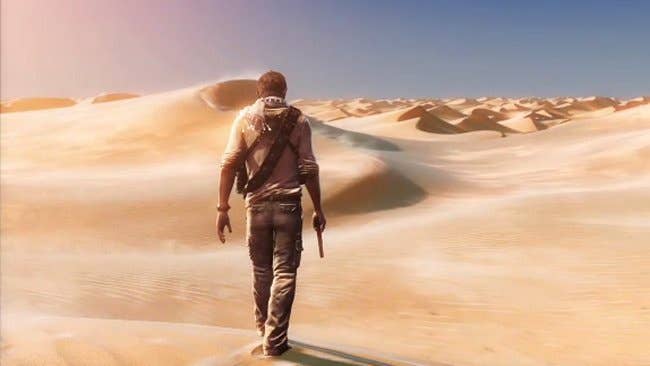Building Uncharted 3
Richard Lemarchand describes the delicate balance of technology and creativity behind Naughty Dog's latest
As 2009 drew to close, Naughty Dog was faced with a problem.
Not a harsh problem, or a disturbing problem. Not the sort of problem that causes a company to come crashing down, leading to cancelled projects and heavy redundancies. No, this was a rare sort of problem that only a small handful of studios ever have the right mix of talent and good fortune to tackle: Uncharted 2: Among Thieves had been released to a shrill cacophony of critical adulation and ringing cash registers. It was being lauded as a new milestone in interactive spectacle and storytelling, even as it was selling millions of units to adoring PlayStation fans.
The problem? Naughty Dog had to make another one.
So, yes, a problem. An enviable, privileged problem, and one that Naughty Dog's gregarious lead designer Richard Lemarchand doesn't mind pondering one little bit.
"The success of Uncharted 2 was something that was unparalleled in any of our experience," he says, smiling, a compelling fusion of utter sincerity and stating-the-bleeding-obvious.
"I think really each one of us has reacted to it differently. We all felt the pressure to rise to the challenge of making something as good as or better than Uncharted 2. But my philosophy has been that if you spend your time doing whatever kind of work you do, really focused [and] not working towards any kind of secondary goals like praise or awards or anything, but just trying to do the best that you can in your craft, that is the real key to success."
We came to it with what Zen Buddhists call the 'Beginner's Mind' - not resting on any laurels, not making any assumptions
According to Lemarchand, this was the approach that allowed Naughty Dog to make the quantum leap from the polished and likeable Uncharted: Drake's Fortune to the frequently astounding Among Thieves.
"We just set to it and applied ourselves with gusto. We came to it with what Zen Buddhists call the 'Beginner's Mind' - not resting on any laurels, not making any assumptions."
The suggestion that there was no room for improvement goes too far - melee combat and multiplayer were just two of a number of key areas that Naughty Dog immediately highlighted for refinement - but so too does the notion that Uncharted 3: Drake's Deception required another giant step forward. Nobody could reasonably expect another revolution, and, excessive hand-wringing over review scores aside, nobody who was swept along by Uncharted 2's artful rollercoaster ride would have wanted it anyway.
The fact is that Drake's Deception is the product of a studio at the very top of its game: pushing the limits of familiar hardware, finding new depths in fully realised characters, finding innovative applications for techniques that it invented and very nearly perfected in the space of a single game. Naughty Dog is bigger now than at the start of Among Thieves, but it is also better prepared, and has more resources at its disposal.
Take its "lovely, beautifully designed" new offices, complete with custom motion-capture studio, for example. The bulk of the motion-capture work is still completed on the Sony lot in Culver City - "It's actually the same lot where Gone with the Wind and the Wizard of Oz were filmed" - but Drake's Deception's animation team is now able to try out new ideas and "experiment" with more freedom.
The evidence of this improved attention to detail is apparent in the game, with long, varied contextual animations streamed directly from the disc.
"We have idle animations in Uncharted 3 that are over 12 minutes now," says Lemarchand. "We can stream them, we don't need lots of memory, we just need the disc access time. We also just put in a lot of extra polish onto Drake and other characters. He'll reach out and touch walls as he passes them, which is something that we tried not to overdo, but it does further the naturalistic look his animation has and sell him as a real human being as you steer him through the environments."

Indeed, one of the more widely reported problems with Among Thieves was a knock-on effect of its lush environments: in situations where players had to identify the correct route for Drake to traverse the sheer amount of detail proved confusing, drawing the eye to random objects and causing stretches of trial-and-error experimentation and frustrating dead-ends. This is exactly the sort of minor flaws that Naughty Dog has defined and eradicated for Drake's Deception.
"I'm not quite sure who it was - either our lead gameplay programmer Travis McIntosh or it might have been one of our lead artists, Teagan Morrison - they came up with the idea for a system whereby we could find out from the many play-tests we conducted for Uncharted 3 exactly where people were mistaking a piece of environmental detail for a ledge or surface that they could climb," says Lemarchand. "Every time that someone tried to jump up to something and didn't succeed, we recorded what we called a 'bad jump point' and recorded it in space with exact detail. We can tell where the player is and their progression when they made these bad jumps. Then we could see those bad jumps in the game engine."
"So let's say that there's a pipe on a part of the wall that isn't a climbing point forward and there's a cluster of red dots underneath; we would know to raise that pipe up out of reach or take it out altogether or model it in some different way. It was such a simple thing to do...but it made a positive difference to the quality of the game."
